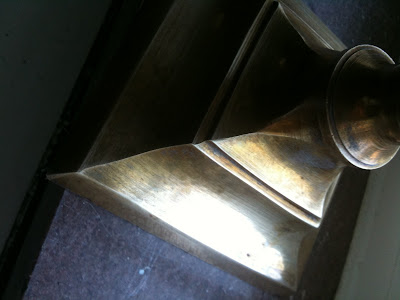I get
really excited every time I get a chance to redo a bathroom. Well, not just any bathroom - it has to be one of those cute and little half bathrooms. You know, that teeny, tiny little nook off the main downstairs hallway? Love. Them. To. Pieces.
Anyway, when it comes to these little spaces, I think you need to either go big or go home. Half baths should be looked at as a great place to experiment, letting that inner designer go wild and take some risks. For example, is there a wallpaper you've had your eye on but think it's too crazy to fit within your calming, pristine space? Or a color you've become obsessed with but just can't justify painting an entire room with something so bold? Answer to both questions: put it in the half bathroom!
Being on a bit of a stripe kick lately, I decided to stripe the bathroom in the top secret project I've been working on over the last week. Now, I have no idea if I'm allowed to show you this but, since no confidentiality agreement was officially signed and it's a primary part of the design, I'm going for it (sorry, Vest).
NOTE: This should be considered a weekend project vs. an after-work project. While the space to paint is small, the amount of detail that's required to figure out the measurements and making sure all lines are straight can take about a billion years to complete.
What you'll need:
1 gallon of paint color #1
9" Purdy roller (3/8" nap)
9" roller handle (with extension if possible)
Large paint holder with disposable paint tray (or Press 'N Seal!)
1 quart of paint color #2
2" Purdy edging brush (trust me - it'll be worth the extra cost)
3-4" roller
3-4" roller handle
Small paint holder with disposable paint tray
2 rolls of painters tape (1.5" or 2" will work)
Small level
Step one: Choose your paint.
Find a swatch you like best, making sure there are at least two shades difference between the colors. In this case, I kept it fresh with
Benjamin Moore Florida Keys and Waterfall. For a more dramatic look, try choosing colors opposite each other on the
color wheel.
Once you've chosen the colors, paint the entire bathroom the lighter of the two, leaving the darker color for the actual striping. Apply two coats.
Step two: Do the math.
Measure the width of all walls you want to stripe. For example, if two walls are 80" and the other two are 25", the total amount of wall I'm working with would be 210". Then divide (keeping the stripes between 6-8 inches), trying to get the stripe widths as even as possible. So, if I take 210" of wall space, I will need to make 35 stripes, each 6" wide.
Step three: Measure out the stripes.
Starting at the center of the wall with the most area to cover, begin taping off the stripes. Be sure to consider the actual tape width within your measurement, designating the tape as part of the stripe you won't be painting. Make sense?
To avoid confusion (or at least try to), stick an extra piece of tape in the area of the stripe that doesn't require painting to clearly mark.
Step four: Tape off the stripes.
Using the small level, begin taping off the stripes from the floor to the ceiling based on how you've marked off the room. To avoid continually climbing up and down, I completed all of the tape work I could while standing on the ground first, finishing off with the work requiring a ladder. For those of you that appreciate a better workout, opt for one line at a time.
NOTE: This takes, by far, the most amount of time. If there is a chance you may need to separate the work into two days, consider this task the separator.
Step five: Paint the stripes.
Using your edging brush and 3" roller, begin painting the stripes in the darker color. Work your way from one end to the other, applying two coats.
NOTE: Don't wait a long period of time before painting the second coat. Since interior paint is typically latex based, painter's tape should be removed from the wall prior to the paint being completely dry. Otherwise, the paint may peel off with the tape, causing a lot of rework.
Instead, paint in a circular pattern so that you are able to easily keep track of which stripes have one coat, which stripes need two and which stripes are ready for the tape to come off.
LESSON LEARNED: Double and triple check which stripes were marked off as staying the lighter color before starting to slather on the paint. Luckily, I realized I was painting the wrong spot pretty quickly and was able to just touch up the area once everything dried.
Step six: Remove the tape and touch up.
After you've applied the second coat, immediately begin to peel off the painter's tape, starting at the first stripe you painted and ending on the last. Work your way around the room until all pieces of tape have been removed. Then, once the paint is fully dry, make the necessary touch ups (look for uneven paint,obvious bleeding, corner work, etc.).



























